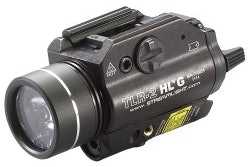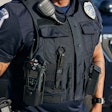 Photo: Dave Douglas
Photo: Dave Douglas
When you think you need to find a new duty holster, it sounds like a simple task, doesn't it? Well, that's only if you define simple as something that can save your life or end up killing you. That might sound a bit overly dramatic, but when it comes down to it, your duty holster is one of the most important articles of safety equipment you'll ever take into the field — just as important as your firearm, cruiser, flashlight, or handcuffs. And, it's not an easy decision anymore. The easiest decision is plain, basket weave, or Clarino. Your department uniform code usually makes that one for you. But, now come the harder and arguably the most important decisions.
Retention Levels
Get 10 firearm instructors together and ask them to explain retention levels and you'll get 13 different answers. Retention levels can be really tricky and the only true way of ensuring that any particular holster provides your desired retention level is to put your hands on it and give it an extensive test. Also, don't get caught up in the "retention level" assigned a particular holster by its manufacturer. There is no actual standard adhered to by the entire holster industry.
Some manufacturers say Level I requires some sort of locking device like a thumb break. Others argue that gravity, a tension screw, or friction qualifies as Level I. Either way it's the minimally accepted level for a duty holster and should only be deployed in plain-clothes assignments like detectives, officers in an admin assignment, or off-duty carry.
Retention Level II generally requires two locking devices and Retention Level III requires three locking devices. If you are in uniform working patrol, Retention Level II and III are the only ones you should consider. If you've ever been through any type of officer safety class you should remember videos of prison gang members practicing gun takeaways right in the prison exercise yard. That's real stuff and even if you have a Retention Level 9 holster you cannot get complacent. The bad guys are practicing to relieve you of your sidearm and use it on you.
Security vs. Safety
There's a trade-off between security and safety. I know, they sound synonymous, but if you really think about it they aren't. As the retired rangemaster for a large Southern California police department I had more than a few officers fail to qualify on their first attempt with stage one of our qualification—two rounds, center of mass, on a turning target, with a two-second presentation. Their first move would be to press the release mechanism; second, they'd reach up and move the hood or bale forward and out of the way; thirdly, they would re-grip their firearm and start to extract it from the holster. Somewhere between steps two and three they'd see the turning target face away. Their holsters were secure, but they weren't safe—at least for their level of competence.
In the world of duty holsters security equates to the ability of the holster to prevent a bad guy from taking your gun no matter how many switches, levers, bales, hoods, buttons, snaps, twists, or rocking motions required. Safety equates to your ability to rapidly draw and deploy your firearm in a crisis situation no matter how many switches, levers, bales, hoods, buttons, snaps, twists, or rocking motions you must defeat. Finding the "sweet spot" between security and safety is entirely up to you and highly dependent on your level of competence with a particular holster.
The only way to develop competency is practice—and a lot of it. It takes about 5,000 perfectly practiced draws to achieve a mastered level of competence with a holster—some argue 10,000. Remember, it's a highly perishable skill requiring continued practice—100 draws each day before your shift. You'll be surprised how quickly you can accomplish that task.
Fit the Gun
Firearm manufacturers can change their gun specifications from time to time. Different manufacturers have totally different specifications for what is essentially the same gun. This is especially true for the 1911 series of pistol with a weapon-mounted accessory rail for a light, laser, or combination unit. Colt, Kimber, Springfield, SIG Sauer, and many others make a 1911 with a rail. They are all great guns, but one single holster designated for a 1911 with accessory rail will not fit all those guns. Some will be too loose; some too tight; and some will be just right—it's kind of like "Goldilocks and the Three Bears."
So, make sure your gun fits the holster you want. And the only way to do it is to try your gun in that holster. It should hold the gun securely and not allow it to rattle around. Additionally, it should not bind during the draw stroke or be too hard to re-insert. When the adrenaline is pumping you want both the draw and re-holstering to go smoothly from muscle memory. This area too benefits from repeated perfect practice.
High, Mid, or Low Ride
Are you male or female? Are you riding a motor, pushing a cruiser around, on bike patrol, walking a downtown beat, or serving in a tactical unit? Each instance can dictate the style of holster you should wear.
Believe it or not, the female body is different than that of the male. You should write that down—it could be on the test. With all other points like age, weight, height, and musculature proportionally factored in, a woman's pelvic bones generally are wider spaced than a man's. A mid-ride and especially a high-ride holster can cause major problems for a female officer in her ability to efficiently draw her firearm due to the angle the holster takes to conform to the officer's hips. The butt of the gun will be angled in toward the waist, thus not allowing the weapon to be drawn straight up. You need to leave sufficient room for a smooth, rapid, and easy draw. Additionally, because the gun is angled in it often rubs on the waist, becomes very uncomfortable, and ruins uniform shirts. Female officers should consider a low–ride holster or some manufacturers offer a wedge that attaches the holster to the belt attachment system, which provides the correct angle. The wedge allows the comfortable use of a mid-ride or even a high-ride.
Motor officers and bicycle patrol officers are on and off their vehicles many times during a shift. The movements, which differ significantly from entering and exiting a patrol car, can make any holster very uncomfortable. High-ride holsters seem to work best for both motor officers and bicycle patrol. The old swivel-style holsters are still available, but usually only offered as Retention Level I systems.
The make, model, and configuration of the car you drive have significant impact on the comfort and usability of your holster. Unless the cruiser is configured to accommodate a holster, a low-ride rig may push your belt up and allow the butt of your firearm to dig into your side. The seat belt strap may cover a high-ride or mid-ride rig and not allow you to draw from a seated and belted-in position. You need to test first.
Durability and Comfort
Holster manufacturers are in the business to make money. Most take your safety and comfort very seriously. But, even if they make the best duty holster ever conceived, if they can't make money, and therefore can't buy the materials or the machines needed for manufacturing or pay their employees, that holster will go the way of the dinosaurs. You cannot just go on a holster maker's website and read their description of a certain holster—usually concocted by marketing people—and take that as gospel. Also, ask the manufacturer and retailer about their return policy. What about repair? Will they send a replacement to use until yours is repaired? How long will it take and who pays for the shipping?
You need to inspect the build quality of the internal mechanism and the security devices. Take a very close look at the belt attachment system and make sure it's substantial. What you don't need is some meth-monster or PCP devotee going for your gun and ripping the holster and gun off of your belt.
If you live in a colder climate, will the belt attachment system allow your jacket to slip between the holster and your body? This allows for easy access to your firearm and less chance of your gun hanging up on your clothing during the draw cycle. It also allows for unimpeded re-holstering when you need to secure your duty gun and go "hands-on."
Usually, injection-molded plastic or nylon is good on the durability scale, but it may not be as comfortable as leather. However, leather is much more susceptible to weather.
Some of we more experienced cops—the ones you call dinosaurs and perhaps rightfully so—have suffered injuries over the years. Injuries are not exclusive to one's membership in the dinosaur club. Police work can be rough no matter your age. Comfort comes into play here. Can you draw from a high-ride Retention Level III holster without wincing in pain? I sure can't. I need a mid-ride or low-ride rig to maintain the speed necessary for an efficient draw cycle.
Practice, Darn It
Using your holster properly is just as perishable a skill as is pursuit driving or firearm accuracy. You really need to practice no matter which holster you choose. Putting in a little time with a couple different duty holsters is invaluable. You need to be confident and competent with your safety gear. Ask other officers you work with what they prefer and why. If someone has a particular holster you're interested in ask if you can borrow it for testing on his or her days off. Try three or four different types from different manufacturers. Once you have made a decision and made your purchase, start practicing.
Whatever you do, don't take your brand new sparkling holster in the field on day one. If the balloon goes up and that incredible surge of adrenaline courses through your system your muscle memory will still be anchored to the old holster system. Start the 5,000- to 10,000-draw regimen first to break the old muscle memory and replace it with what is needed for your new holster. Once that's accomplished you're ready to go.
Retired sergeant Dave Douglas is a longtime contributor to POLICE Magazine. He retired after 30 years with the San Diego Police Department as the rangemaster and is currently a Special Deputy for Investigations at the Archuleta Sheriff's Office in Colorado.















